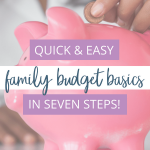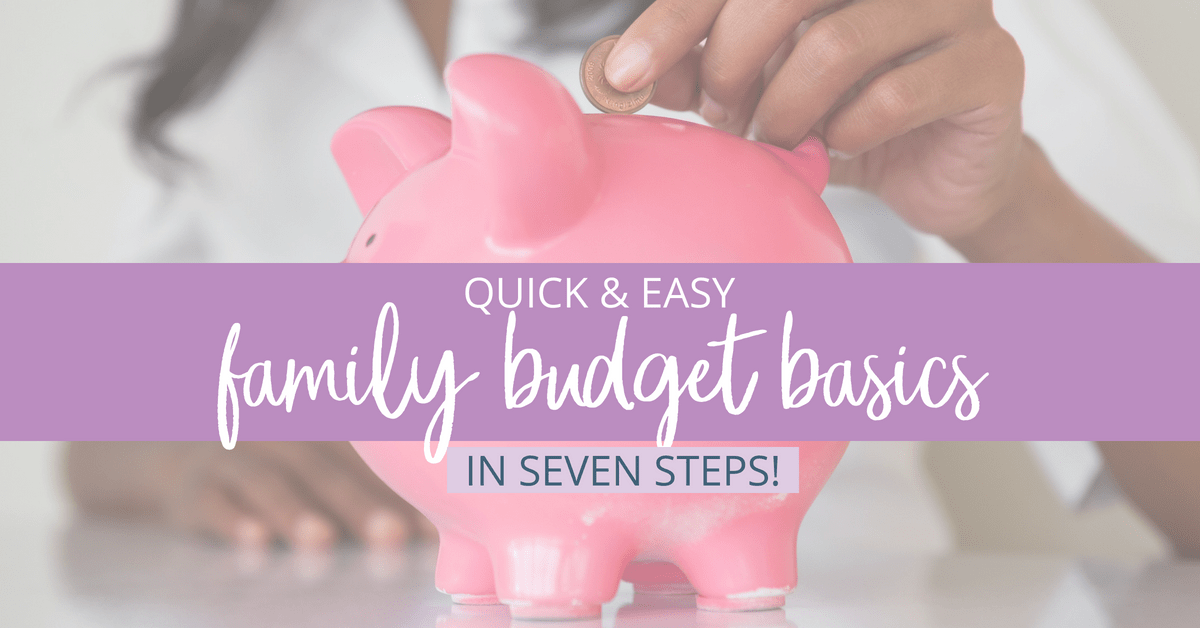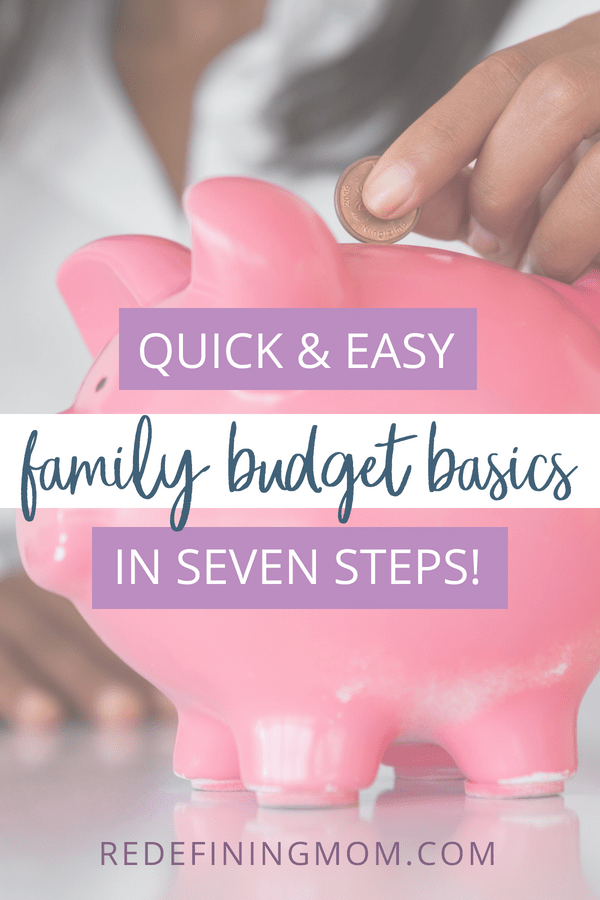This post may contain affiliate links, which means if you purchase from one of these links I will receive a commission. Please read my full privacy policy for more information.
Each time you take out your credit card, your stress level rises a bit. This week it’s birthday presents, haircuts, and car repairs going on your card. Your paychecks should be covering these expenses, but there’s just not enough in the checking account right now. And with car insurance due next month, you’ll only be able to make the minimum payment on your card balance. It’s becoming clear you need a lesson in family budget basics.
I’ve been there, and I get it. Managing money becomes more of a struggle as your family grows – which isn’t a surprise. But how do you find time for one more thing with all that you already do?
I understand you feel overwhelmed but getting a handle on your family finances matters. Figuring out the basics of a family budget takes work in the beginning – but I promise, it’s worth it in the end!
If I Can Pay My Bills on Time, Why Budget?
It’s a mistake to think of a budget as merely a list of what you must pay. Using a family budget worksheet is a key part of budgeting, but there’s a lot more to it.
You’ll be looking at income and expenses, and the gap between those to develop your budget – rather than just paying your bills each month.
Mastering family budget basics allows you to take control of your spending, pay down debt, boost savings, and reach important family goals.
And it reduces the stress you feel about money as you prioritize what matters while creating new money habits.
Family Budget Basics in Seven Steps
If someone tries to tell you making a budget is quick and easy, they’re wrong. If you were never taught to manage money or if you just aren’t good at it, it’s definitely work. And budgeting is an ongoing process, not a one-time event.
But budgeting is a skill you can learn, and you’ll get better at it as time goes on. And believe me, your future self will thank you for investing the time to do it right.
Let’s get started!
1. Collect Your Paperwork
Gather your household’s paychecks, receipts, bills, and bank and credit card statements. Try to go back as many months as you can. And don’t forget everything you earn and spend online too. Make estimates of any income or expenses you can’t find documentation for because the more information you have, the better.
2. Money Coming In
Take your stack of papers and put everything representing income in one pile. Include income from all full- or part-time jobs. If you work any side hustles, remember to include the income from them as well.
If you receive any type of government benefits or payments such as child support, add it to the money coming into your household each month. If you have an income source that varies such as being paid on commission, do your best to make a conservative estimate of what you earn each month.
Whether you are paid weekly or biweekly, estimate your family’s income for one month.
3. Money Going Out
Take a deep breath before you calculate your expenses. When you look at what your household spends in a month all at one time, it can stop you in your tracks. But this is the time to dig in, not ignore your spending.
Instead of just randomly adding everything up – separate out your expenses into three categories – fixed, variable, discretionary. Fixed expenses include rent, loans (car, mortgage, student loans), and payments such as insurance premiums. Variable expenses include groceries and household items, clothing, utilities, and credit card debt. Discretionary expenses include eating out, travel, gifts, concerts, gym memberships, and cable TV or any other forms of entertainment.
Add up all your family’s spending for each month and determine what you spend in an average month.
4. Address the Gap
You probably see the gap between your income and expenses already. And there’s a good chance your income is less than your monthly spending some months.
That’s why you are stressed about money and paying your bills. The good news? You probably can cut some of your discretionary spending to start closing the budget gap quickly.
If your household income exceeds your family’s spending, what’s happening to the surplus? Is your emergency fund fully funded? Are you getting the company match in your 401k? Are you contributing to a 529 plan for your kids for college? Do you have a holiday or travel fund? Or is the money just disappearing each month?
Whether your spending gap needs to be closed or you need to revisit where the extra money is going each month, a deep dive into your finances will help you make progress.
5. Make Family Budget Goals
Whether it is paying off consumer debt on your credit cards, getting out of a 6- year car loan, wiping out your student loans, or paying extra principal on your mortgage – eliminating debt may be your number one goal.
But don’t forget to invest in your future too. You’ll need to balance paying down debt with saving for retirement.
And make sure you create goals that include important family events and fun. Time goes by fast, and to pay off debt and save for the future, you still need to make family memories in the present too.
6. Create Your Household Budget
Whether you choose to use paper and pencil, a spreadsheet, or an online program – pick whatever you think will work for your household. You can’t master family budget basics if you don’t ever look at your budget.
Create the actual plan you will use to make sure your income supports paying each of your expenses every month. Start at the top with the fixed expenses and work your way down to the discretionary ones.
If you don’t have enough income, start cutting discretionary expenses first. You can then move on to variable expenses and see if there are ways to reduce costs in some of those areas too.
Your final budget should show how much you plan to pay in each area of spending and it should be supported by your income. Make sure you keep receipts and statements for the next month to see how well you stay on your family budget.
7. Monitor and Adjust
Each month, you’ll need to monitor your income and spending and compare it with the household budget you’ve created. You can then adjust and add or delete categories no longer making sense in your family’s plan.
Always make sure to review your family’s budget spreadsheet if you have a big change in income or expenses. Did you buy a house or downsize? Was there a job change in your family? Did you welcome a new baby or are you managing an illness? These can all have a significant impact on your household budget.
Get Started and Make Progress
Understanding family budget basics and creating a household budget you will use is the best way to take control of and understand how money comes in and out of your home.
We all want to do better with money. And while a budget won’t help you make more money, it will help you plan how to use the money you do make to meet your expenses and achieve your goals.
With your family on board, it will be easier to tackle budgeting. And the less stress you have over money – the better it is for everyone in your family.



